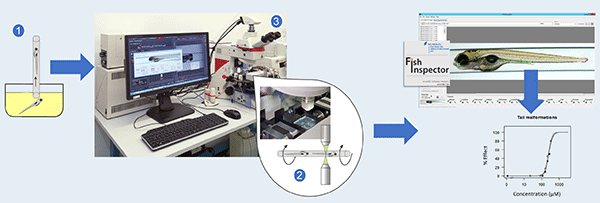#3 High-throughput bioassays with zebrafish embryos

Exposure of zebrafish embryos to single chemicals, mixtures and environmental samples can provoke complex phenotypic patterns which are intended to be used for diagnostic analysis. A critical step to achieve an unbiased observer-independent assessment of phenotypes is automated positioning, imaging and subsequent software-based feature detection. Therefore, we are using the VAST (vertebrate automated screening technology) coupled to a large particle sampler (LPS) and a Leica fluorescence microscope for automated feature analysis in hatched or dechorionated embryos.
The VAST system samples fish embryos from a microplate and transfers them to a capillary. A camera identifies the position of the embryo and images and videos are obtained from defined positions. Furthermore, an attached microscope is controlled by the VAST system and can be used to generate higher resolution or fluorescence images.
The coordinates of specific structures in the images fish embryos are detected by the open source software FishInspector (available at zenodo and github ) (Teixido et al. 2018). Subsequently, the coordinates are used to compare images from treated and control embryos and to derive concentration response curves using automated workflows.Application:
Assessment of morphology and heart rate alterations in zebrafish embryos
Main components
2. VAST system for positioning and imaging (10 µm resolution) of fish embryos
3. Leica fluorescence microscope DM16 to obtain higher resolution and fluorescence images
4. Zebrabox for behavior analysis of fish embryos (not yet implemented)
5. Sorting devise for fish embryos (not yet implemented)
Literature references
Jarque S, Fetter E, Veneman WJ, Spaink HP, Peravali R, Strahle U, Scholz S. 2018. An automated screening method for detecting compounds with goitrogenic activity using transgenic zebrafish embryos. PLoS One 13:e0203087.
Teixido E, Kießling TR, Krupp E, Quevedo C, Muriana A, Scholz S. 2018. Automated morphological feature assessment for zebrafish embryo developmental toxicity screens. Tox Sci in press.
Bittner, L., Teixido, E., Seiwert, B., Escher, B.I. and Klüver, N. (2018). Influence of pH on the uptake and toxicity of β-blockers in embryos of zebrafish, Danio rerio. Aquatic Toxicology, 201: 129-137.
